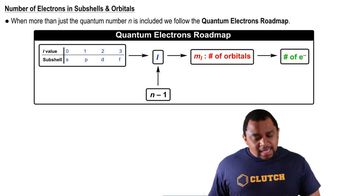9. Quantum Mechanics
Quantum Numbers: Number of Electrons
9. Quantum Mechanics
Quantum Numbers: Number of Electrons
Additional 3 creators.
Learn with other creators
Showing 6 of 6 videos
Practice this topic
- Multiple Choice
Determine the number of electrons that can have the following set of quantum numbers:n = 3, ml = 0.
864views4rank1comments - Multiple Choice
Determine the number of electrons that can have the following set of quantum numbers:n = 2, ms = –1/2.
818views2rank - Multiple Choice
Determine the number of electrons that can have the following set of quantum numbers.
n = 4, l = 3, ml = – 1
737views3rank1comments - Multiple Choice
Determine the number of electrons that can have the following set of quantum numbers.
n = 4, mL = – 1, ms = –1/2
820views4rank2comments - Open QuestionHow many electrons in an atom could have these sets of quantum numbers?384views
- Open QuestionWhat is the maximum number of electrons in an atom that can have the following quantum numbers?326views
- Open QuestionWhat is the maximum number of electrons that can occupy each of the following subshells?337views
- Open Question
What is the maximum number of electrons that can exist in the g sublevel?
283views










